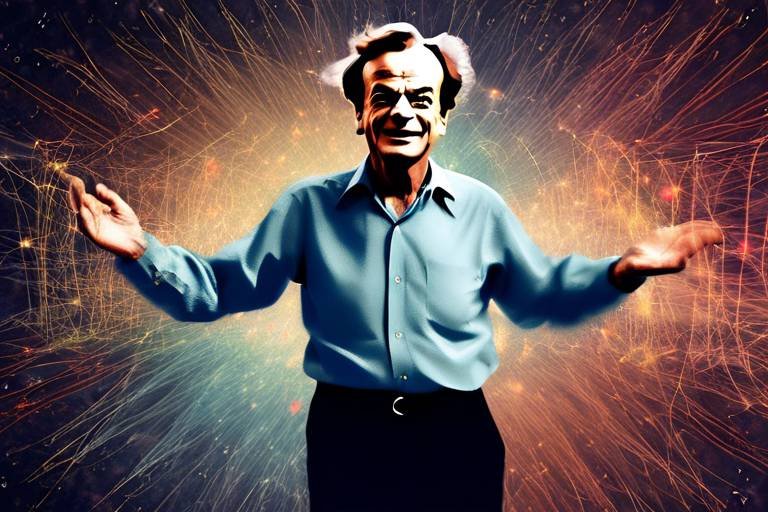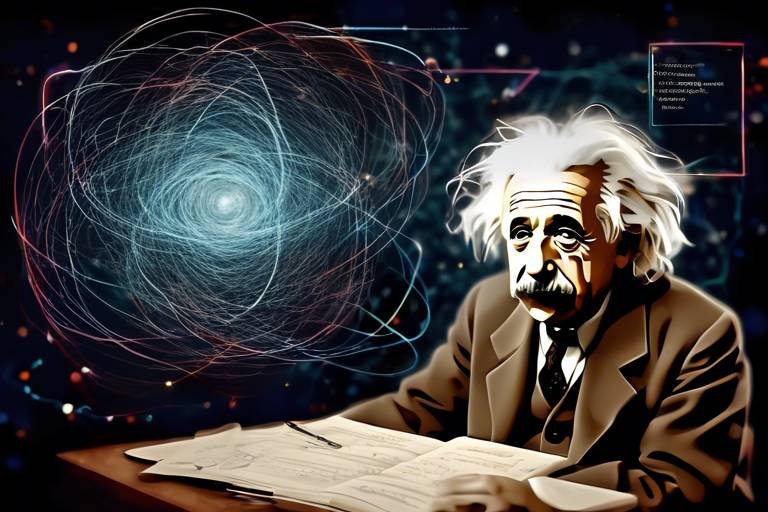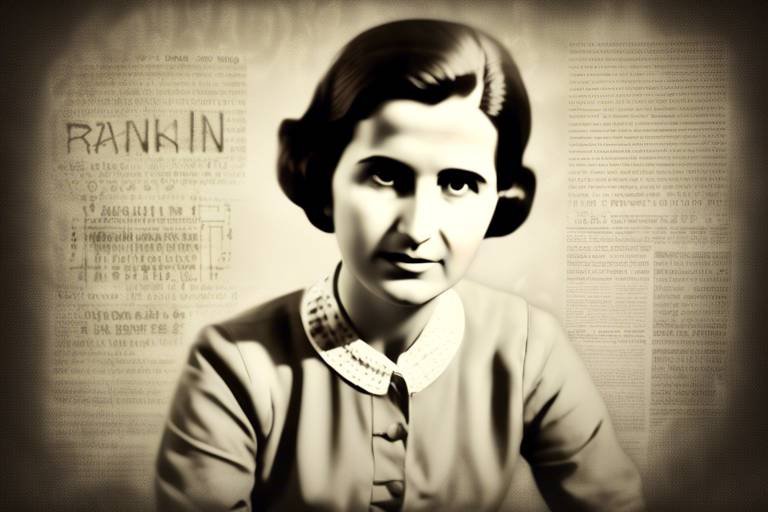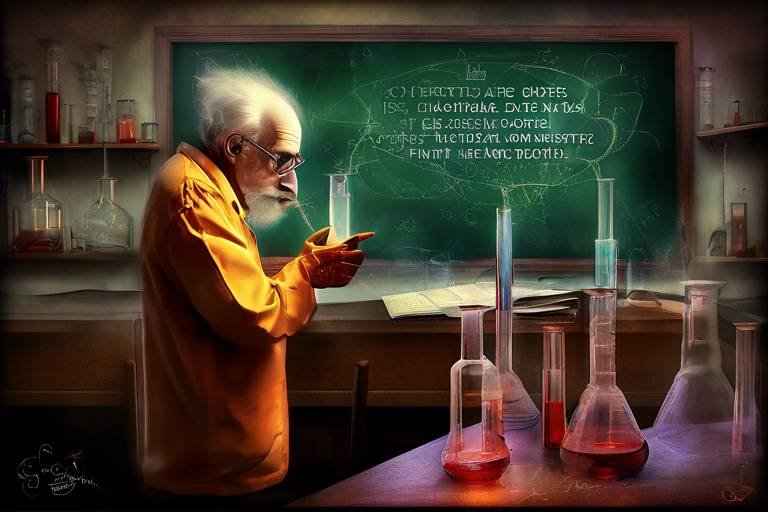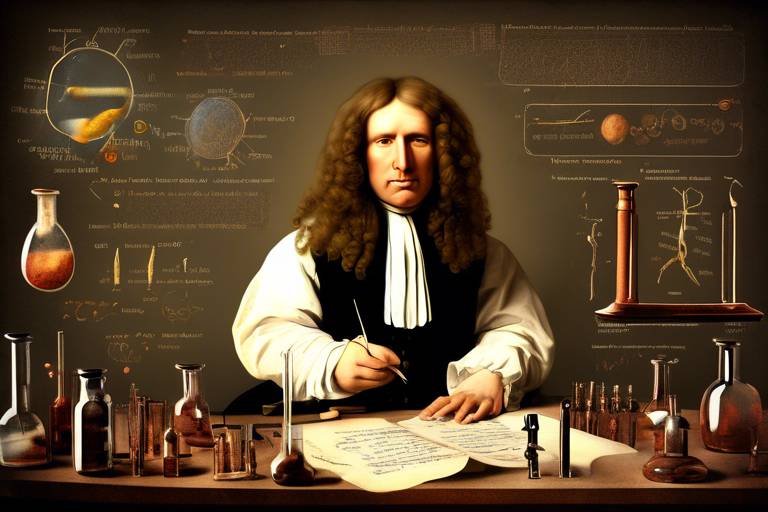Richard Feynman - The Physicist Who Danced with Particles
Richard Feynman is not just a name in the annals of physics; he is a legend, a vibrant personality who brought a unique flair to the world of science. Born on May 11, 1918, in New York City, Feynman’s early life was marked by an insatiable curiosity and a knack for understanding the intricate workings of the universe. His journey through academia began at the prestigious Massachusetts Institute of Technology (MIT), where he honed his skills in physics, and later, he earned his Ph.D. from Princeton University. It was here that he started to lay the groundwork for what would become groundbreaking contributions to quantum mechanics.
Feynman's approach to physics was anything but conventional. He had a remarkable ability to simplify complex concepts, making them accessible to anyone willing to listen. His lectures were legendary, filled with enthusiasm and a touch of humor, captivating audiences and igniting a passion for science in many. It’s this unique blend of charisma and intellect that made him not just a physicist, but a true ambassador for science.
With a mind that danced among particles, Feynman revolutionized our understanding of quantum mechanics. He introduced the world to the path integral formulation, a concept that allowed physicists to visualize the different ways particles can move from one point to another. This was not just a theoretical exercise; it was a paradigm shift that reshaped the landscape of particle physics. Feynman's work provided the tools to explain phenomena that were previously thought to be too complex to understand, allowing scientists to delve deeper into the quantum realm.
One of Feynman's most significant contributions is the creation of Feynman diagrams. These diagrams are not just pretty pictures; they are powerful visual representations of particle interactions that simplify the intricate calculations involved in quantum field theory. They have become essential tools for physicists, enabling them to communicate complex ideas clearly and efficiently. Imagine trying to navigate a dense forest without a map; Feynman diagrams serve as that map, guiding researchers through the tangled underbrush of particle interactions.
Beyond his scientific achievements, Feynman's legacy is deeply embedded in popular culture. His engaging personality and witty remarks have made him a beloved figure in media, inspiring countless references in films, books, and documentaries. Feynman’s life story is not just about equations and theories; it’s about a man who approached life with a sense of wonder and adventure, reminding us all to embrace curiosity and creativity.
In essence, Richard Feynman was a physicist who didn’t just study particles; he danced with them, bringing them to life through his words and ideas. His impact on the scientific community is immeasurable, and his legacy continues to inspire new generations of scientists and curious minds alike.
- What was Richard Feynman known for?
Feynman was known for his contributions to quantum mechanics, particularly the path integral formulation and Feynman diagrams, which revolutionized the field of particle physics. - What is a Feynman diagram?
A Feynman diagram is a graphical representation used in particle physics to visualize and calculate interactions between particles. - How did Feynman influence science education?
Feynman was a passionate teacher whose engaging lectures and books made complex scientific concepts accessible, inspiring countless students to pursue careers in science. - What is Feynman's legacy?
Feynman's legacy includes his scientific contributions, his unique personality, and his ability to communicate complex ideas in an understandable way, leaving a lasting impact on both science and culture.

Early Life and Education
Richard Feynman's journey began in the bustling streets of New York City, where he was born on May 11, 1918. Growing up in a family that embraced curiosity and learning, Feynman's early fascination with science was evident. His father, a schoolteacher, instilled in him a love for understanding the world, often encouraging young Richard to ask questions and explore the mysteries around him. This nurturing environment laid the foundation for a mind that would later revolutionize the field of physics.
Feynman's educational path took him to the prestigious Massachusetts Institute of Technology (MIT), where he pursued his undergraduate studies. Here, he excelled in his coursework, fueled by an insatiable curiosity and a knack for problem-solving. Feynman was not just an ordinary student; he was known for his unconventional methods and unique approach to learning. He often engaged in spirited debates with professors and peers, challenging established norms and seeking deeper understanding.
After completing his bachelor's degree, Feynman continued his academic journey at Princeton University, where he earned his Ph.D. in physics. His time at Princeton was marked by groundbreaking work that would later become pivotal in the realm of quantum mechanics. During this period, he developed a reputation for his ability to simplify complex concepts, making them more accessible to others. Feynman's doctoral thesis, which focused on the behavior of quantum systems, showcased his innovative thinking and set the stage for his future contributions to the field.
Throughout his education, Feynman was not just a brilliant student; he was also an avid learner outside the classroom. He had a passion for music, particularly the bongo drums, and often entertained friends with his rhythmic skills. This blend of intellectual curiosity and artistic expression exemplified the multifaceted nature of Feynman's personality. He believed that engaging with different disciplines enriched his understanding of physics, and this holistic approach would later influence his teaching style.
Feynman's early life and education were characterized by a relentless pursuit of knowledge and a unique perspective on the world. His formative years in New York, coupled with his rigorous academic training at MIT and Princeton, equipped him with the tools to become one of the most influential physicists of the 20th century. The combination of his inquisitive nature, unconventional thinking, and passion for science paved the way for a career that would forever change our understanding of the universe.

Contributions to Quantum Mechanics
Richard Feynman was a true pioneer in the realm of quantum mechanics, a field that often feels like a mystifying dance of particles. His contributions not only changed the landscape of physics but also reshaped our understanding of the universe itself. One of his most significant innovations was the introduction of the path integral formulation, which provided a new way of thinking about quantum mechanics. Instead of focusing solely on the classical trajectory of particles, Feynman proposed that particles could take multiple paths simultaneously, each contributing to the final outcome. This revolutionary idea allowed physicists to calculate probabilities in a more intuitive manner, making the complex world of quantum phenomena a bit more manageable.
Feynman's approach was akin to viewing a grand symphony, where every note played contributes to the overall harmony, even if they seem disjointed at first. His insights helped explain phenomena that previously baffled scientists, such as the behavior of electrons in atoms and the interactions of particles at high energies. The implications of his work extended far beyond theoretical musings; they laid the groundwork for practical applications in various fields, including quantum computing and quantum cryptography.
One of the most iconic tools developed by Feynman is the Feynman diagram, a graphical representation that simplifies the complex interactions between particles. These diagrams serve as a visual shorthand for physicists, allowing them to depict and calculate particle interactions with remarkable ease. Imagine trying to explain a complicated dance routine without any visuals; it would be a daunting task! Feynman diagrams break down these interactions into manageable parts, making it easier to predict outcomes in quantum field theory.
Feynman diagrams have become indispensable in theoretical physics for several reasons:
- Simplification: They translate complex mathematical equations into intuitive visual forms.
- Communication: They allow physicists to convey ideas and findings succinctly, fostering collaboration across the scientific community.
- Insightful Calculations: They help in calculating scattering amplitudes, which are crucial for understanding particle interactions.
By providing a clear framework for visualizing particle interactions, Feynman diagrams have significantly advanced the field of quantum mechanics, enabling researchers to tackle problems that once seemed insurmountable.
In the realm of particle physics, Feynman diagrams are not just theoretical tools; they are vital for conducting real-world research. Scientists use these diagrams to calculate scattering amplitudes, which are essential for predicting the outcomes of high-energy particle collisions. For instance, when particles collide in a particle accelerator, the results can be complex and unpredictable. However, by applying Feynman diagrams, physicists can gain insights into fundamental forces and particles, helping to unravel the mysteries of the universe.
In summary, Richard Feynman's contributions to quantum mechanics have left an indelible mark on the field. Through his innovative ideas and tools, he transformed the way we understand the quantum world, making it more accessible and comprehensible to both scientists and the public alike. His legacy continues to inspire countless physicists, driving them to explore the unknown and push the boundaries of what we know about the universe.

Feynman Diagrams
Feynman diagrams are not just mere illustrations; they are powerful tools that have transformed the way physicists understand particle interactions. Imagine trying to navigate a complex city without a map—confusing, right? That's how particle interactions felt before Feynman introduced his diagrams. These visual representations allow scientists to simplify and visualize the complex calculations involved in quantum field theory, making it easier to grasp the intricate dance of particles at the subatomic level.
At their core, Feynman diagrams depict the interactions between particles as lines and vertices in a two-dimensional space. Each line represents a particle, while the points where lines meet signify interactions. This straightforward representation gives physicists a clear roadmap to follow when analyzing particle behavior. The beauty of Feynman diagrams lies in their ability to convey complex ideas in a way that is both intuitive and accessible. They essentially turn the abstract world of quantum mechanics into a visual narrative, allowing scientists to see the 'story' behind particle interactions.
To illustrate their significance, consider the following key aspects of Feynman diagrams:
- Simplification of Calculations: By breaking down interactions into visual components, physicists can perform calculations more efficiently, reducing the likelihood of errors.
- Predictive Power: Feynman diagrams enable researchers to predict the outcomes of particle collisions, which is crucial for experiments conducted in particle accelerators.
- Communication Tool: These diagrams serve as a universal language among physicists, facilitating clearer communication of complex ideas.
The impact of Feynman diagrams extends beyond theoretical physics; they play a crucial role in practical applications as well. For instance, in high-energy physics experiments, scientists utilize these diagrams to calculate scattering amplitudes—essentially determining the probabilities of various outcomes when particles collide. This application is vital in experiments conducted at facilities like CERN, where understanding particle interactions can lead to groundbreaking discoveries.
In summary, Feynman diagrams are a testament to Richard Feynman's innovative spirit. They not only revolutionized the study of particle physics but also opened up new avenues for research and understanding in the quantum realm. As we delve deeper into the mysteries of the universe, these diagrams continue to be indispensable tools for physicists, guiding them through the complexities of the quantum world.
- What are Feynman diagrams used for?
Feynman diagrams are used to visually represent particle interactions and simplify calculations in quantum field theory. - Who invented Feynman diagrams?
Feynman diagrams were introduced by physicist Richard Feynman in the 1940s as part of his work in quantum electrodynamics. - How do Feynman diagrams help in experiments?
They help physicists predict outcomes of particle collisions, making them essential for experiments in high-energy physics.

Significance of Feynman Diagrams
Feynman diagrams are not just mere illustrations; they are a revolutionary tool that transformed the way physicists approach complex problems in quantum field theory. Imagine trying to solve a complicated puzzle without a visual guide—it's daunting, right? Feynman’s diagrams provide that much-needed clarity, allowing scientists to visualize particle interactions in a way that is both intuitive and insightful. By representing particles as lines and their interactions as vertices, these diagrams simplify the intricate dance of particles, making the abstract concepts of quantum mechanics more tangible.
One of the most significant aspects of Feynman diagrams is their ability to simplify calculations that would otherwise be overwhelmingly complex. For instance, when physicists calculate probabilities for particle interactions, they often encounter a web of equations that can seem like a labyrinth. Feynman diagrams break this down into manageable parts, enabling researchers to focus on the essential elements of the interaction. This simplification is akin to having a roadmap in a foreign city; it guides you through the maze and helps you reach your destination without getting lost.
Moreover, Feynman diagrams facilitate communication among physicists. In a field where jargon can often create barriers, these diagrams serve as a universal language. They allow scientists from different backgrounds and specializations to share ideas and collaborate effectively. For example, a physicist in Japan can present their findings to a colleague in the United States using these diagrams, bridging the gap created by language and cultural differences. This aspect of Feynman diagrams underscores their role not just as a computational tool, but as a means of fostering collaboration and innovation in the scientific community.
In practical terms, Feynman diagrams are essential in various applications within particle physics, especially in calculating scattering amplitudes. These calculations are crucial for predicting the outcomes of high-energy collisions in particle accelerators, such as the Large Hadron Collider. By using Feynman diagrams, physicists can visualize and compute the probabilities of different interaction outcomes, which is vital for understanding fundamental forces and particles in the universe.
In summary, the significance of Feynman diagrams extends beyond their mathematical utility. They represent a paradigm shift in the way physicists conceptualize and communicate complex ideas. By transforming abstract concepts into visual forms, they have not only made quantum mechanics more accessible but have also paved the way for future discoveries in the field. In a world where the mysteries of the universe can often feel impenetrable, Feynman diagrams illuminate the path forward, making the dance of particles a little less mysterious and a lot more fascinating.
- What are Feynman diagrams? Feynman diagrams are graphical representations of particle interactions used in quantum field theory to simplify complex calculations and visualize interactions.
- Why are Feynman diagrams important? They simplify calculations, enhance communication among physicists, and are essential for predicting outcomes in particle physics experiments.
- How do Feynman diagrams aid in research? They help physicists calculate scattering amplitudes and understand fundamental forces and particles more clearly.

Applications in Particle Physics
Feynman diagrams are not just pretty pictures; they are the backbone of modern particle physics, allowing scientists to visualize and compute complex interactions between particles. Imagine trying to navigate a bustling city without a map; that's what particle physicists would face without these diagrams. They provide a clear and concise way to represent interactions, making the unfathomable more digestible.
One of the primary applications of Feynman diagrams is in calculating scattering amplitudes. This process involves determining the probability of particles interacting and scattering off one another. Each line and vertex in a Feynman diagram corresponds to specific mathematical expressions, representing particles and their interactions. By translating these diagrams into mathematical equations, physicists can predict the outcomes of high-energy collisions, such as those that occur in particle accelerators like the Large Hadron Collider (LHC).
Moreover, these diagrams have provided insights into fundamental forces, such as electromagnetism and the weak nuclear force. They allow researchers to break down complex interactions into manageable components, which can be analyzed and understood more easily. For instance, in the context of quantum electrodynamics (QED), Feynman diagrams illustrate how light interacts with charged particles, leading to predictions that have been confirmed by numerous experiments.
Let’s take a closer look at some specific applications of Feynman diagrams in particle physics:
- Quantum Chromodynamics (QCD): Feynman diagrams are essential in studying the strong force, which binds quarks together inside protons and neutrons.
- Electroweak Theory: They help in understanding the unification of electromagnetic and weak forces, providing a framework for predicting outcomes in particle collisions.
- Particle Decay Processes: Feynman diagrams can be used to visualize and calculate the decay rates of unstable particles, which is crucial for understanding the stability of matter.
In summary, Feynman diagrams have revolutionized the way physicists approach particle interactions. They transform abstract concepts into visual representations that can be manipulated mathematically, leading to breakthroughs in our understanding of the universe. Without these diagrams, the intricate dance of particles would remain a mystery, obscured by the complexities of quantum mechanics. Feynman's legacy lives on through these powerful tools, continuing to guide researchers in their quest to unlock the secrets of the cosmos.
Q: What are Feynman diagrams?
A: Feynman diagrams are graphical representations used to visualize and calculate interactions between particles in quantum field theory. They simplify complex calculations and help physicists predict outcomes of particle interactions.
Q: How do Feynman diagrams aid in particle physics research?
A: They allow researchers to break down complicated interactions into simpler components, making it easier to calculate scattering amplitudes and understand fundamental forces at play in particle physics.
Q: Can Feynman diagrams be applied to all areas of physics?
A: While Feynman diagrams are primarily used in quantum field theory and particle physics, their conceptual framework can be adapted to other areas of physics, such as condensed matter physics.
Q: Who was Richard Feynman?
A: Richard Feynman was a renowned physicist known for his contributions to quantum mechanics and particle physics. He developed the path integral formulation of quantum mechanics and introduced Feynman diagrams as a tool for visualizing particle interactions.

Teaching and Public Engagement
Richard Feynman was not just a physicist; he was a master communicator who had a knack for making the most complicated concepts in science feel like a friendly chat over coffee. His approach to teaching was as vibrant and dynamic as his personality. Feynman believed that science should not be confined to the walls of academia; rather, it should be a shared experience that everyone could enjoy. This belief fueled his passion for public engagement, where he transformed the way physics was perceived by the masses.
One of the most remarkable aspects of Feynman's teaching style was his ability to simplify complex ideas. He often used analogies and real-world examples to explain abstract concepts, making them relatable to his audience. For instance, he famously compared the behavior of particles to a game of chess, where each move had consequences that could lead to unexpected outcomes. This analogy not only made the subject matter accessible but also sparked curiosity and excitement among his students and listeners.
Feynman's lectures were legendary, filled with enthusiasm and a sense of wonder that was contagious. He had a unique way of engaging with his audience, often encouraging questions and discussions, which fostered an interactive learning environment. His famous series of lectures at the California Institute of Technology, known as the Feynman Lectures on Physics, are still celebrated today for their clarity and insight. These lectures have been compiled into a book that remains a go-to resource for students and enthusiasts alike, demonstrating his lasting impact on education.
In addition to his lectures, Feynman was a prolific writer. His books, such as Surely You're Joking, Mr. Feynman! and What Do You Care What Other People Think?, offer a glimpse into his life and thoughts, blending humor with profound insights into the nature of science and the human experience. Through these works, he reached a broader audience, inspiring countless individuals to explore the wonders of physics and science in general.
Feynman also took part in various public speaking engagements, where he tackled not only scientific topics but also philosophical questions about life, curiosity, and the pursuit of knowledge. His ability to articulate complex ideas in a straightforward manner made him a sought-after speaker at conferences and events. He often emphasized the importance of curiosity in science, urging people to ask questions and seek answers, which is the essence of scientific inquiry.
Moreover, Feynman's charisma and engaging storytelling made him a popular figure in popular culture. He appeared on television shows, including The Tonight Show, where he captivated audiences with his charm and intelligence. His ability to connect with people from all walks of life helped demystify the world of physics, making it more accessible to those outside the scientific community.
In summary, Richard Feynman's contributions to teaching and public engagement were profound. He not only reshaped the way physics was taught but also inspired a generation of thinkers to embrace science with open arms. His legacy as a teacher and communicator continues to resonate, reminding us that science is not just about equations and theories; it’s about understanding the world around us and sharing that understanding with others.
- What was Richard Feynman's teaching style like?
Feynman was known for his engaging and interactive teaching style, using analogies and real-world examples to simplify complex topics.
- What are the Feynman Lectures on Physics?
These are a series of lectures given by Feynman at Caltech, compiled into a book that serves as a comprehensive introduction to physics.
- How did Feynman contribute to public understanding of science?
Through his lectures, books, and public appearances, Feynman made science accessible and exciting, encouraging curiosity and inquiry.

Legacy and Impact
Richard Feynman's legacy is as vibrant and multifaceted as the particles he studied. His impact on the world of physics transcends the confines of academia, resonating through popular culture and inspiring countless individuals. Feynman was not just a physicist; he was a charismatic communicator who had a knack for making the complex seem simple. His ability to convey intricate ideas in a relatable manner has made him a beacon for aspiring scientists and curious minds alike.
One of the most profound aspects of Feynman's legacy is his approach to problem-solving. He taught that science is not merely a collection of facts but a process of inquiry and exploration. His famous quote, "The first principle is that you must not fool yourself—and you are the easiest person to fool," encapsulates his belief in the importance of skepticism and self-reflection in scientific endeavors. This philosophy has inspired generations of physicists to question assumptions and think critically about their work.
Feynman's influence extends into the realm of education. His lectures, particularly those at the California Institute of Technology, were not just courses; they were experiences. Students didn't just learn physics; they were captivated by the joy of discovery. He famously said, "If you can't explain it to a six-year-old, you don't understand it yourself," highlighting the importance of clarity in teaching. His books, such as Surely You're Joking, Mr. Feynman! and The Feynman Lectures on Physics, continue to be popular resources for both students and educators, serving as gateways into the world of science.
Moreover, Feynman's personality left an indelible mark on the scientific community. He was known for his wit, humor, and an insatiable curiosity that extended beyond physics. Whether it was playing the bongo drums, safe-cracking, or painting, Feynman approached life with the same enthusiasm he brought to his scientific work. This zest for life has made him a relatable figure, and many see him as a reminder that science can be fun and engaging.
Feynman's legacy is also evident in the way he has been embraced by popular culture. References to his life and work can be found in various media, from documentaries to films. His story serves as a testament to the idea that science is not just for the elite; it is for everyone. Feynman's life reminds us that curiosity and creativity are essential components of scientific inquiry. This has led to a resurgence of interest in physics, particularly among young people who see Feynman as a role model.
In summary, Richard Feynman's legacy is profound and far-reaching. His contributions to physics are monumental, but it is his unique approach to teaching, problem-solving, and life itself that has left a lasting impact on both the scientific community and popular culture. As we continue to explore the mysteries of the universe, Feynman's spirit encourages us to ask questions, embrace uncertainty, and, most importantly, to have fun along the way.
- What are Feynman diagrams?
Feynman diagrams are graphical representations used in particle physics to visualize and calculate interactions between particles. They simplify complex equations and make it easier for physicists to understand particle interactions.
- How did Feynman contribute to quantum mechanics?
Feynman revolutionized quantum mechanics with his path integral formulation and introduced Feynman diagrams, which have become essential tools in theoretical physics.
- Why is Feynman considered a great teacher?
Feynman had a unique ability to make complex scientific concepts accessible and engaging. His lectures and books continue to inspire students and educators alike.
- What is Feynman's legacy in popular culture?
Feynman's charisma and humor have made him a beloved figure in media, with numerous references in films, books, and documentaries, showcasing his enduring influence.

Influence on Future Physicists
Richard Feynman was more than just a brilliant physicist; he was a beacon of inspiration for countless future scientists. His unique approach to understanding the universe and his ability to convey complex ideas in a simple, engaging manner left an indelible mark on the field of physics. Many physicists today attribute their passion and career choices to Feynman's influence, as he transformed the way science is perceived and taught.
Feynman's lectures, particularly those captured in the famous “Feynman Lectures on Physics”, have become a staple in the education of aspiring physicists. His enthusiasm was contagious, and his ability to break down intricate concepts into digestible nuggets of knowledge made learning physics feel less like a chore and more like an adventure. Imagine diving into the mysteries of the universe with a guide who not only knows the terrain but also makes the journey enjoyable! This is precisely what Feynman offered to his students.
Moreover, Feynman's emphasis on curiosity and exploration encouraged many to pursue their own scientific inquiries. He famously said, “The first principle is that you must not fool yourself—and you are the easiest person to fool.” This statement resonates deeply within the scientific community, reminding future physicists to maintain integrity and skepticism in their research. Feynman’s insistence on questioning established norms and thinking outside the box has inspired a generation of scientists to challenge the status quo and seek innovative solutions.
In addition to his lectures, Feynman's playful personality and storytelling ability have made physics more relatable. He often used analogies and metaphors to explain complex phenomena, making them accessible to those who might otherwise feel intimidated by the subject. For instance, he compared the behavior of electrons to that of dancers in a chaotic ballet, illustrating the unpredictable nature of quantum mechanics in a way that anyone could visualize. This approach not only captivated students but also opened the door for interdisciplinary connections, bridging the gap between science and the arts.
Feynman's influence extends beyond the classroom. Many physicists who grew up idolizing him have gone on to make significant contributions to the field, carrying forward his legacy of innovation and creativity. They often cite his work as a catalyst for their own research, whether it be in quantum mechanics, particle physics, or even emerging fields like quantum computing. Feynman’s spirit of inquiry lives on in their explorations, pushing the boundaries of what we know about the universe.
In conclusion, Richard Feynman’s impact on future physicists is profound and far-reaching. His unique teaching style, emphasis on curiosity, and ability to make physics fun have inspired countless individuals to pursue careers in science. As we look to the future, it is clear that Feynman's legacy will continue to shape the minds of aspiring physicists, encouraging them to explore the wonders of the universe with the same passion and enthusiasm that he exemplified.
- What made Richard Feynman such an influential physicist?
Feynman's unique approach to teaching, his innovative ideas in quantum mechanics, and his ability to engage the public in science made him a highly influential figure in physics. - How did Feynman contribute to quantum mechanics?
He introduced the path integral formulation and Feynman diagrams, which revolutionized the way physicists understand particle interactions. - What are Feynman diagrams?
Feynman diagrams are graphical representations of particle interactions that simplify complex calculations in quantum field theory. - Why are Feynman's lectures still popular today?
His engaging style and ability to simplify complex concepts make his lectures accessible and enjoyable for students and science enthusiasts alike.

Popular Culture References
Richard Feynman was not just a towering figure in the realm of physics; he also became a cultural icon, resonating with audiences far beyond the confines of academia. His larger-than-life personality, coupled with his remarkable ability to explain complex scientific concepts in a relatable manner, has led to numerous references in popular culture. From documentaries to films, Feynman’s legacy is celebrated in various forms, making him a household name even among those who may not fully grasp the intricacies of quantum mechanics.
One of the most notable portrayals of Feynman is in the acclaimed documentary "The Pleasure of Finding Things Out." This film showcases not only his scientific achievements but also his quirky personality and zest for life. Viewers are treated to a glimpse of Feynman’s playful approach to learning, as he shares anecdotes about his experiences, including his time as a physicist during the Manhattan Project and his love for bongo drumming. His infectious enthusiasm is palpable, making the documentary a must-watch for anyone curious about the man behind the science.
Feynman has also made appearances in fictional works, such as the popular TV show "The Big Bang Theory." In one memorable episode, his character is referenced when the protagonists discuss the complexities of quantum physics, highlighting how Feynman’s work continues to inspire even fictional scientists. This kind of cultural nod not only pays homage to Feynman’s contributions but also serves to spark interest in physics among a broader audience.
Moreover, Feynman's life and work have inspired various books, including "Surely You're Joking, Mr. Feynman!" This collection of autobiographical anecdotes provides readers with a fascinating insight into his unconventional thinking and approach to problem-solving. The book has become a staple recommendation for students and science enthusiasts alike, illustrating how Feynman’s wit and wisdom can be applied beyond the realm of physics.
Feynman's charisma has also made him a subject of interest in educational content. Numerous online courses and lectures reference his teaching methods, emphasizing the importance of curiosity and exploration in scientific inquiry. His famous lectures at Caltech, which were recorded and are available online, continue to engage and inspire students, making physics accessible and enjoyable.
In summary, Richard Feynman’s impact on popular culture is profound and multifaceted. His ability to bridge the gap between complex scientific ideas and everyday understanding has ensured that his legacy endures. Whether through documentaries, fictional references, or educational materials, Feynman remains a vibrant symbol of curiosity and the joy of discovery.
- What are Feynman diagrams? Feynman diagrams are graphical representations used in quantum field theory to visualize interactions between particles, simplifying complex calculations.
- How did Feynman contribute to quantum mechanics? Feynman introduced innovative concepts such as the path integral formulation, which revolutionized our understanding of quantum phenomena.
- Why is Feynman considered a great teacher? Feynman had a unique ability to explain intricate scientific concepts in an engaging and relatable manner, making science accessible to a broader audience.
- What are some popular works featuring Feynman? Notable works include "Surely You're Joking, Mr. Feynman!" and documentaries like "The Pleasure of Finding Things Out."
Frequently Asked Questions
- Who was Richard Feynman?
Richard Feynman was a renowned physicist known for his groundbreaking work in quantum mechanics and particle physics. He was not just a brilliant scientist but also an engaging teacher and a colorful personality who made science accessible to everyone.
- What are Feynman Diagrams?
Feynman diagrams are visual tools used to represent particle interactions in quantum field theory. They simplify complex calculations and help physicists predict outcomes by illustrating how particles interact over time.
- How did Feynman contribute to quantum mechanics?
Feynman revolutionized quantum mechanics with his path integral formulation, which provided a new way to understand particle behavior. His innovative ideas clarified complex phenomena, significantly advancing the field.
- Why are Feynman Diagrams significant?
These diagrams are crucial because they allow physicists to communicate complex ideas clearly and efficiently. They have become essential in theoretical physics, helping researchers to visualize and calculate particle interactions.
- What impact did Feynman have on education?
Feynman was an exceptional teacher who inspired countless students through his engaging lectures and books. He had a unique ability to explain difficult concepts in a relatable way, making science exciting and approachable.
- How did Feynman influence future physicists?
Many physicists cite Feynman as a key inspiration in their careers. His innovative thinking and passion for science continue to motivate new generations of researchers and students in the field.
- What is Feynman's legacy in popular culture?
Feynman's charisma and wit have made him a beloved figure in popular culture, with numerous references in films, books, and documentaries. His legacy lives on as a symbol of curiosity and the joy of discovery in science.

